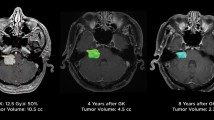Abstract
The pupose of this study is to assess the long-term outcome and toxicity of fractionated stereotactic radiation therapy (FSRT) and stereotactic radiosurgery (SRS) for 100 vestibular schwannomas treated at a single institution. From 1993 to 2007, 104 patients underwent were treated with radiation therapy for vestibular schwannoma. Forty-eight patients received SRS, with a median prescription dose of 12.5 Gy for SRS (range 9.7–16 Gy). For FSRT, two different fraction schedules were employed: a conventional schedule (ConFSRT) of 1.8 Gy per fraction (Gy/F) for 25 or 28 fractions to a total dose of 45 or 50.4 Gy (n = 19); and a once weekly hypofractionated course (HypoFSRT) consisting of 4 Gy/F for 5 fractions to a total dose of 20 Gy (n = 37). Patients treated with FSRT had better baseline hearing, facial, and trigeminal nerve function, and were more likely to have a diagnosis of NF2. The 5-year progression free rate (PFR) was 97.0 after SRS, 90.5 % after HypoFSRT, and 100.0 % after ConFSRT (p = NS). Univariate analysis demonstrated that NF2 and larger tumor size (greater than the median) correlated with poorer local control, but prior surgical resection did not. Serviceable hearing was preserved in 60.0 % of SRS patients, 63.2 % of HypoFSRT patients, and 44.4 % of ConFSRT patients (p = 0.6). Similarly, there were no significant differences in 5-year rates of trigeminal toxicity facial nerve toxicity, vestibular dysfunction, or tinnitus. Conclusions:Equivalent 5-year PFR and toxicity rates are shown for patients with vestibular schwanoma selected for SRS, HypoFSRT, and ConFSRT after multidisciplinary evaluation. Factors correlating with tumor progression included NF2 and larger tumor size.


Similar content being viewed by others
References
Plotkin SR, Stemmer-Rachamimov AO, Barker FG, Halpin C, Padera TP, Tyrrell A, Sorensen AG, Jain RK, di Tomaso E (2009) Hearing improvement after bevacizumab in patients with neurofibromatosis type 2. N Engl J Med 361:358–367
Tomé WA, Meeks SL, Buatti JM, Bova FJ, Friedman WA, Li Z (2000) A high-precision system for conformal intracranial radiotherapy. Int J Radiat Oncol Biol Phys 47:1137–1143
Tomé WA, Meeks SL, McNutt TR, Buatti JM, Bova FJ, Friedman WA, Mehta M (2001) Optically guided intensity modulated radiotherapy. Radiother Oncol 61:33–44
Pollock BE (2006) Management of vestibular schwannomas that enlarge after stereotactic radiosurgery: treatment recommendations based on a 15 year experience. Neurosurg 58:241–248
Karpinos M, Teh BS, Zeck O, Carpenter LS, Phan C, Mai WY, Lu HH, Chiu JK, Butler EB, Gormley WB, Woo SY (2002) Treatment of acoustic neuroma: stereotactic radiosurgery vs. microsurgery. Int J Radiat Oncol Biol Phys 54:1410–1421
Andrews DW, Suarez O, Goldman HW, Downes MB, Bednarz G, Corn BW, Werner-Wasik M, Rosenstock J, Curran WJ (2001) Stereotactic radiosurgery and fractionated stereotactic radiotherapy for the treatment of acoustic schannomas: comparative observations of 125 patients treated at one institution. Int J Radiat Oncol Biol Phys 50:1265–1278
Meijer OW, Vandertop WP, Baayen JC, Slotman BJ (2003) Single-fraction vs. fractionated linac-based stereotactic radiosurgery for vestibular schwannoma: a single-institution study. Int J Radiat Oncol Biol Phys 56:1390–1396
Combs SE, Welzel T, Schulz-Ertner D, Huber PE, Debus J (2010) Differences in clinical results after linac-based single-dose radiosurgery versus fractionated stereotactic radiotherapy for patients with vestibular schwannoma. Int J Radiat Oncol Biol Phys 76:193–200
Collen C, Ampe B, Gevaert T, Moens M, Linthout N, De Ridder M, Verellen D, D’Haens J, Storme G (2011) Single fraction versus fractionated linac-based stereotactic radiotherapy for vestibular schwannoma: a single-institution experience. Int J Radiat Oncol Biol Phys 81:e503–e509
Myrseth E, Moller P, Wentzel-Larsen T, Goplen F, Lund-Johansen M (2006) Vestibular schwannoma: surgery or gamma knife radiosurgery? A prospective, nonrandomized study. Neurosurg 59:67–76
Banerjee R, Moriarty JP, Foote RL, Pollock BE (2008) Comparison of the surgical and follow-up costs associated with microsurgical resection and stereotactic radiosurgery for vestibular schwannoma. J Neurosurg 108:1220–1224
Foote KD, Friedman WA, Buatti JM, Meeks SL, Bova FJ, Kubilis PS (2001) Analysis of risk factors associated with radiosurgery for vestibular schwannoma. J Neurosurg 95:440–449
Chung WY, Liu KD, Shiau CY, Wu HM, Wang LW, Guo WY, Ho DM, Pan DH (2005) Gamma knife surgery for vestibular schwannoma: 10-year experience of 195 cases. J Neurosurg 102(Suppl):87–96
Flickinger JC, Kondziolka D, Niranjan A, Lunsford LD (2001) Results of acoustic neuroma radiosurgery: an analysis of 5 years’ experience using current methods. J Neurosurg 94:1–6
Flickinger JC, Kondziolka D, Pollock BE, Lunsford LD (1996) Evolution in technique for vestibular schwannoma radiosurgery and effect on outcome. Int J Radiat Oncol Biol Phys 36:275–280
Chihara Y, Ito K, Sugasawa K, Shin M (2007) Neurological complications after acoustic neurinoma radiosurgery: revised risk factors based on long-term follow-up. Acta Otolaryngol Suppl 559:65–70
Andrews DW, Werner-Wasik M, Den RB, Paek SH, Downes-Phillips B, Willcox TO, Bednarz G, Maltenfort M, Evans JJ, Curran WJ (2009) Toward dose optimization for fractionated stereotactic radiotherapy for acoustic neuromas: comparison of two dose cohorts. Int J Radiat Oncol Biol Phys 74:419–426
Myrseth E, Moller P, Pedersen PH, Lund-Johansen M (2009) Vestibular schwannoma: surgery or gamma knife radiosurgery? A prospective, nonrandomized study. Neurosurg 64:654–661
Pollock BE, Driscoll CL, Foote RL, Link MJ, Gorman DA, Bauch CD, Mandrekar JN, Krecke KN, Johnson CH (2006) Patient outcomes after vestibular schwannoma management: a prospective comparison of microsurgical resection and stereotactic radiosurgery. Neurosurg 59:77–85
Regis J, Pellet W, Delsanti C, Dufour H, Roche PH, Thomassin JM, Zanaret M, Peragut JC (2002) Functional outcome after gamma knife surgery or microsurgery for vestibular schwannomas. J Neurosurg 97:1091–1100
Conflict of interest
The authors declare that they have no conflict of interest.
Author information
Authors and Affiliations
Corresponding author
Rights and permissions
About this article
Cite this article
Anderson, B.M., Khuntia, D., Bentzen, S.M. et al. Single institution experience treating 104 vestibular schwannomas with fractionated stereotactic radiation therapy or stereotactic radiosurgery. J Neurooncol 116, 187–193 (2014). https://doi.org/10.1007/s11060-013-1282-4
Received:
Accepted:
Published:
Issue Date:
DOI: https://doi.org/10.1007/s11060-013-1282-4




